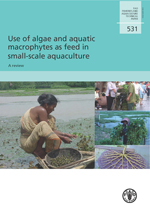
FAO FISHERIES AND AQUACULTURE TECHNICAL PAPER 531
 |
FAO FISHERIES AND AQUACULTURE TECHNICAL PAPER 531 Use of algae and aquatic
A review |
|
FOOD AND AGRICULTURE ORGANIZATION OF THE UNITED NATIONS
|
||
|
Download ZIP Version |
||
The designations employed and the presentation of material in this information product do not imply the expression of any opinion whatsoever on the part of the Food and Agriculture Organization of the United Nations (FAO) concerning the legal or development status of any country, territory, city or area or of its authorities, or concerning the delimitation of its frontiers or boundaries. The mention of specific companies or products of manufacturers, whether or not these have been patented, does not imply that these have been endorsed or recommended by FAO in preference to others of a similar nature that are not mentioned. The views expressed in this information product are those of the author(s) and do not necessarily reflect the views of FAO. |
ISBN 978-92-5-106420-7
All rights reserved. Reproduction and dissemination of material in this information product for educational or other non-commercial purposes are authorized without any prior written permission from the copyright holders provided the source is fully acknowledged. Reproduction of material in this information product for resale or other commercial purposes is prohibited without written permission of the copyright holders. Applications for such permission should be addressed to:
Chief, Publishing Policy and Support Branch, Office of Knowledge Exchange, Research and Extension, FAO, Viale delle Terme di Caracalla, 00153 Rome, Italy.
© FAO 2010
Abstract Hasan, M.R.; Chakrabarti, R. This technical paper presents a global review on the use of aquatic macrophytes as feed for farmed fish, with particular reference to their current and potential use by small-scale farmers. The review is organized under four major divisions of aquatic macrophytes: algae, floating macrophytes, submerged macrophytes and emergent macrophytes. Under floating macrophytes, Azolla, duckweeds and water hyacinths are discussed separately; the remaining floating macrophytes are grouped together and are reviewed as ‘other floating macrophytes’. The review covers aspects concerned with the production and/or cultivation techniques and use of the macrophytes in their fresh and/or processed state as feed for farmed fish. Efficiency of feeding is evaluated by presenting data on growth, food conversion and digestibility of target fish species. Results of laboratory and field trials and on-farm utilization of macrophytes by farmed fish species are presented. The paper provides information on the different processing methods employed (including composting and fermentation) and results obtained to date with different species throughout the world with particular reference to Asia. Finally, it gives information on the proximate and chemical composition of most commonly occurring macrophytes, their classification and their geographical distribution and environmental requirements. |
Preparation of this document
Abstract
Abbreviations and acronyms
Introduction
Classification
Characteristics
Production
Chemical composition
Use as aquafeed
2. Floating aquatic macrophytes – Azolla
(Download ![]() - 167 kb)
- 167 kb)
Classification
Characteristics
Production
Chemical composition
Use as aquafeed
3. Floating aquatic macrophytes – duckweeds
(Download ![]() - 708 kb)
- 708 kb)
Classification
Characteristics
Production
Chemical composition
Use as aquafeed
4. Floating aquatic macrophytes – water hyacinths
(Download ![]() - 457 kb)
- 457 kb)
Classification
Characteristics
Production
Chemical composition
Use as aquafeed
5. Floating aquatic macrophytes – others
(Download ![]() - 218 kb)
- 218 kb)
Classification
Characteristics
Production
Chemical composition
Use as aquafeed
6. Submerged aquatic macrophytes
(Download ![]() - 334 kb)
- 334 kb)
Classification
Characteristics
Production
Chemical composition
Use as aquafeed
7. Emergent aquatic macrophytes
(Download ![]() - 120 kb)
- 120 kb)
Classification
Characteristics
Production
Chemical composition
Use as aquafeed
8. Conclusions
(Download ![]() - 73 kb)
- 73 kb)
Algae
Azolla
Duckweeds
Water hyacinths
Other floating macrophytes
Submerged macrophytes
Emergent macrophytes
References
(Download ![]() - 363 kb)
- 363 kb)
Annex 1 Essential amino acid composition of aquatic macrophytes 119
Annex 2 Periphyton